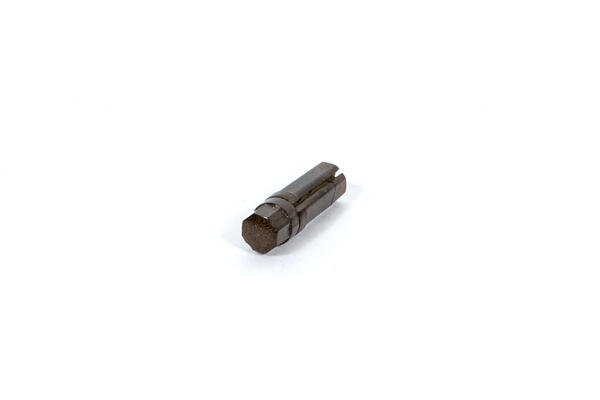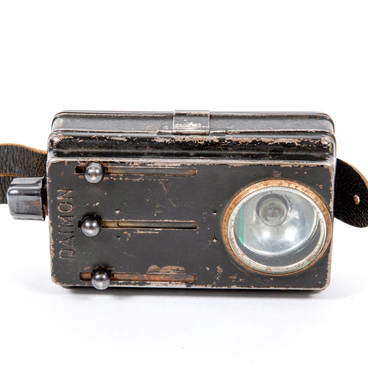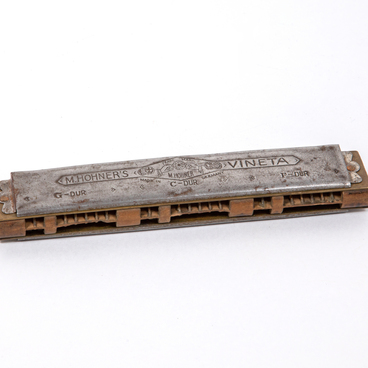The museum collection houses a personal medallion which was carried by all Red Army soldiers and used by the military to record the number of casualties. It was discovered in 2013 during an expedition of the ‘Yamal’ joint search party of the Yamalo-Nenets Autonomous Okrug. It was found near the village of Ryazhenoye in the Matveyevo-Kurgansky District, Rostov Region. In 1941, the Wehrmacht strengthened here its Mius-front defensive line, through which the Red Army broke in August 1943 during the Donbas strategic offensive. During the battles on the Mius-front, the Soviet Union lost 150,000 men who were killed, wounded, imprisoned, or declared missing.
Each Red Army soldier carried his ‘death medallion’ in a special pocket on the outside of his trousers on the right side. It looked like a black octagonal cylindrical case with a screw cap. Soldiers wrote down their personal information on two pieces of paper, one copy stayed in the capsule with the body, the other was collected by the commander as a record and stored in the headquarters of the military unit or military hospital. When a soldier died, the medallion was given to his relatives after the funeral.
In the Red Army, the death medallion was used to identify the soldiers even before the Great Patriotic War. It was introduced in 1925 as an identity document. Each soldier was given a medallion along with his Red Army Booklet (military ID book) upon arrival at the unit.
The first medallions were made in the form of flat tin 5 cm boxes, which were worn around the neck. Inside was a standard form which soldiers filled out (surname, first name, and patronymic, year and place of birth, place of recruitment). Soldiers also wrote down the address of the closest relatives — their partner, mother or father.
In 1937, the death medallions were abolished, but the Red Army ID book was retained. In 1939, the medallion system was reestablished, but during the Soviet-Finnish War, it turned out that the tin box was not leak-proof and the paper inside quickly deteriorated. In June 1940, the tin medallion and the book were abolished again, and in March 1941, by Order No.138 of the People’s Commissariat of Defense of the USSR, new octagonal plastic death medallions were produced.
In October 1941, the Red Army Booklet became the main document for privates and junior commanders. The officers were given identity cards. The identification medallions were used until November 1942 and then were finally abolished.
Each Red Army soldier carried his ‘death medallion’ in a special pocket on the outside of his trousers on the right side. It looked like a black octagonal cylindrical case with a screw cap. Soldiers wrote down their personal information on two pieces of paper, one copy stayed in the capsule with the body, the other was collected by the commander as a record and stored in the headquarters of the military unit or military hospital. When a soldier died, the medallion was given to his relatives after the funeral.
In the Red Army, the death medallion was used to identify the soldiers even before the Great Patriotic War. It was introduced in 1925 as an identity document. Each soldier was given a medallion along with his Red Army Booklet (military ID book) upon arrival at the unit.
The first medallions were made in the form of flat tin 5 cm boxes, which were worn around the neck. Inside was a standard form which soldiers filled out (surname, first name, and patronymic, year and place of birth, place of recruitment). Soldiers also wrote down the address of the closest relatives — their partner, mother or father.
In 1937, the death medallions were abolished, but the Red Army ID book was retained. In 1939, the medallion system was reestablished, but during the Soviet-Finnish War, it turned out that the tin box was not leak-proof and the paper inside quickly deteriorated. In June 1940, the tin medallion and the book were abolished again, and in March 1941, by Order No.138 of the People’s Commissariat of Defense of the USSR, new octagonal plastic death medallions were produced.
In October 1941, the Red Army Booklet became the main document for privates and junior commanders. The officers were given identity cards. The identification medallions were used until November 1942 and then were finally abolished.



